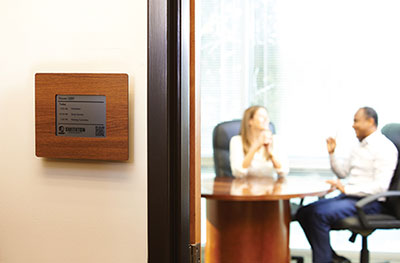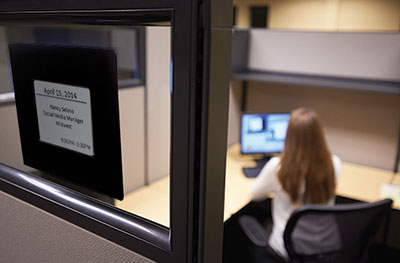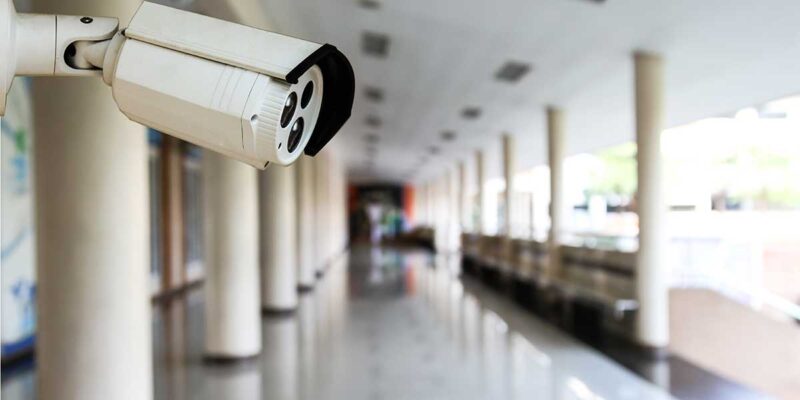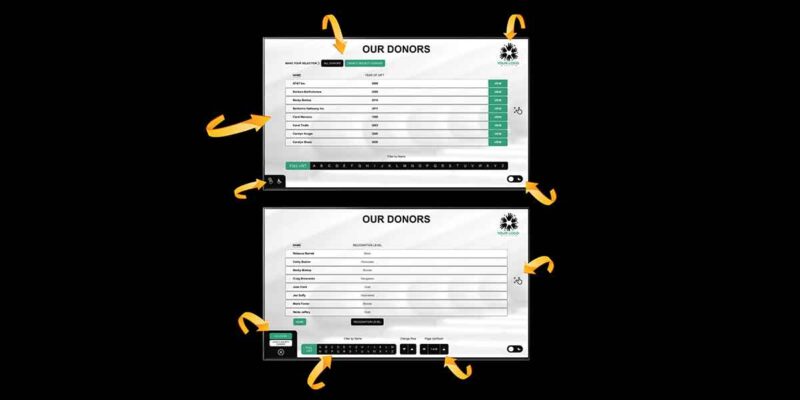Top Six Reasons to Replace Paper Signs With E-Paper Room Signs
By Debbie DeWitt
Marketing Communications Manager, Visix, Inc.
 Many schools and businesses use sheets of paper outside meeting rooms to show who’s using the room and when. This isn’t very practical because the staff has to constantly print out paper sheets, take them down when meetings end, and start the whole process again the next day.
Many schools and businesses use sheets of paper outside meeting rooms to show who’s using the room and when. This isn’t very practical because the staff has to constantly print out paper sheets, take them down when meetings end, and start the whole process again the next day.
E-paper room signs are an affordable option for people who need to display space reservations or event schedules without the need to show other digital signage media or offer interactive scheduling. They’re better than paper for many reasons, and here are the top six:
1. Electronic room signs are modern.
We don’t think anyone will argue that paper signs look good — they can make a beautiful conference area look a bit shabby (plus they’re labor intensive.) Electronic room signs are sleek and modern, and can be customized with frames and mounting that fit your environment.
E-paper signs are small and unobtrusive, and mount easily to walls, glass or other surfaces. You can customize a frame or enclosure to fit your décor, and even tailor the layout of the schedule information on the screen for a seamless, integrated look.
2. E-paper room signs integrate with your calendar program.
You can feed calendar data to e-paper signs using popular programs like Microsoft Exchange, Google Calendars, EMS by Dean Evans and Associates, 25Live by CollegeNet, and Delphi by Newmarket. Or you can import a standard text file with your schedule data if you don’t have a calendar program.
By integrating signs with a scheduling application, you can manage all of your events in one place and have them go to the screens with just a mouse click. Events fall off the schedule automatically, so you don’t have to worry about old information hanging around after events have finished. It’s also a lot easier to click “publish” just one time for everything, rather than format and print individual calendars for each room.
3. E-paper room signs are wireless and battery-operated.
One of the challenges that people worry about when installing room signs is getting all of those wires run through the walls. E-paper signs save you that headache because they don’t need any cabling. They get updates through wireless RF transmission, so no network cables are required. Because they are battery-powered, you don’t have to worry about power cables or bulky power bricks.
4. E-paper room signs are very affordable.
If you have a large training or conference center, fitting out every room with an electronic sign can add up. However, e-paper signs are a very inexpensive option to bring your rooms up to date. With each unit costing only about $275, you can outfit all of your meeting rooms without breaking the bank.
5. E-paper room signs save time, money and waste.
Publishing updates from a desktop is faster and easier than manually printing, posting and removing signs, so you’ll definitely save time, and get back those lost hours of work and productivity from the staffer(s) that had to maintain a paper-based system.
You’ll also be saving on ink, paper and printer maintenance if you bin those paper signs. And there’s the green benefit of saving on the raw materials and waste that printing brings with it.
 6. E-paper room signs are great for office hoteling.
6. E-paper room signs are great for office hoteling.
E-paper signs are small and flexible enough to be used for more than just conference rooms — they can easily attach to a cubicle or workspace for office hoteling.
If you have a mobile workforce, or an activity-based workplace, you can use the signs for temporary desk assignments. Room sign data is quickly and easily updated, just like those used for meeting rooms, and the signs are wireless, so they can easily be moved around your space.
How It Works
E-paper technology is familiar to most of us as e-readers like Kindles or Nooks. They’re wireless, battery-operated, and only use the battery when the information on the screen changes, so batteries can last up to three years or 10,000 updates.

An e-paper room sign system has four components: the signs, an RF transmitter, e-paper sign management software, and your calendar program.
You can use your existing calendar program to manage events. If you’re running multiple event management systems, or multiple instances of those systems, you can use a data combiner application to combine and sort calendar data. That information is then passed on to the sign management software.
The sign management software applies your schedule data to screen layout templates you select, and pushes updates to RF transmitters via your network. The software can also be used to check the status of room signs, check battery power levels and deploy additional room signs. RF transmitters can generally feed all signs within a 150-foot radius, depending on the layout and materials of the facility.
For more information about e-paper room signs, go here.





